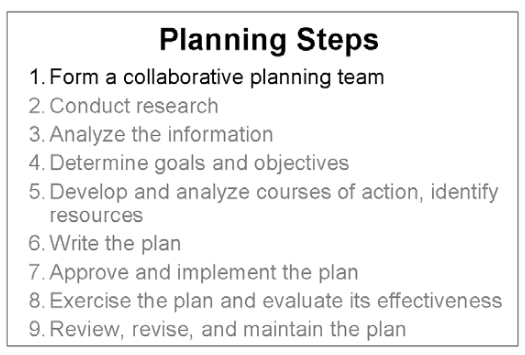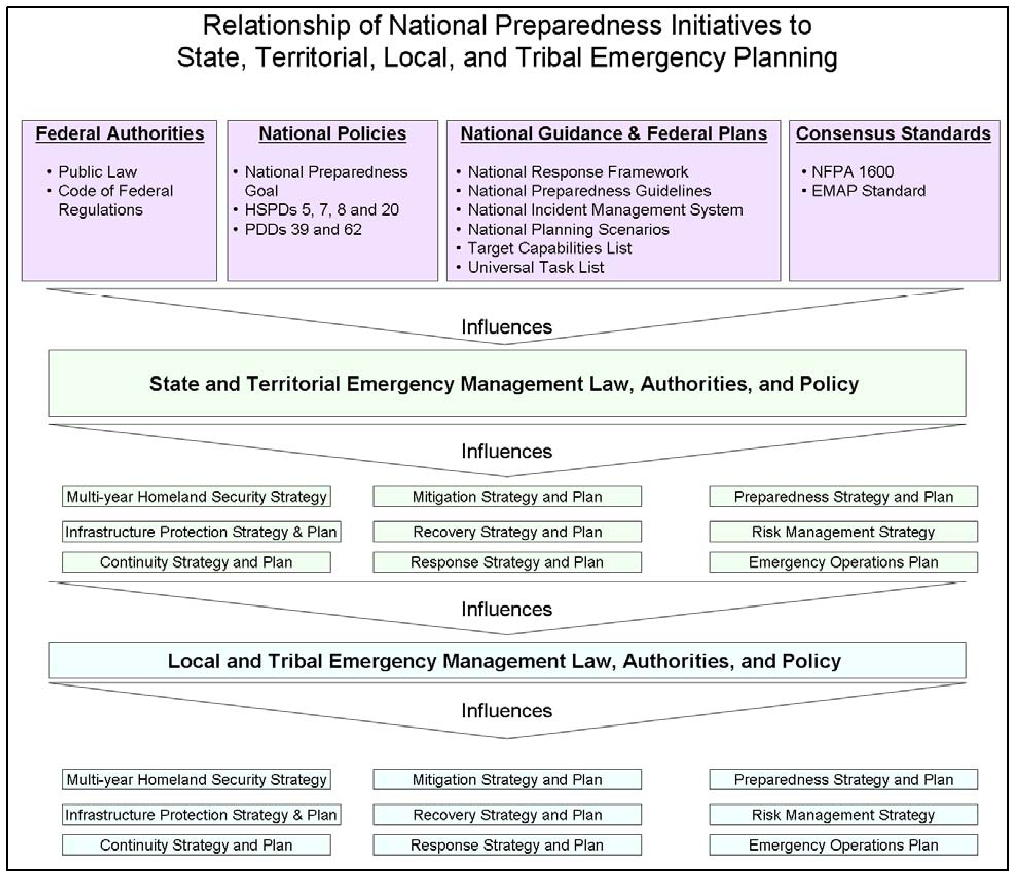 Comprehensive Preparedness Guide (CPG) 101
Comprehensive Preparedness Guide (CPG) 101
- 154 pages
- Draft – Do Not Cite
- For Official Use Only
- 2007
PREFACE
This Comprehensive Preparedness Guide, CPG 101, continues the more -than – 50 -year effort to provide guidance about emergency operations planning to State, Local, Territorial, and Tribal Governments. Some predecessor material can be traced back to the 1960s-era Federal Civil Defense Guide. Long-time emergency management practitioners will also recognize the influence of Civil Preparedness Guide 1-8, Guide for the Development of State and Local Emergency Operations Plans, and State and Local Guide (SLG) 101, Guide for All-Hazards Emergency Operations Planning, in this document.
…
12 While CPG 101 maintains its link to the past, it also reflects the changed reality of
13 the current emergency planning environment. Hurricane Hugo and the Loma
14 Prieta earthquake influenced the development of CPG 1-8. Hurricane Andrew
15 and the Midwest floods shaped the contents of SLG 101. In a similar way,
16 CPG 101 reflects the impacts of the September 11, 2001, terrorist attacks and
17 recent major disasters, such as Hurricanes Katrina and Rita, on the emergency
18 planning community. CPG 101 integrates National Incident Management System
19 (NIMS) concepts and it incorporates recommendations from the 2005 Nationwide
20 Plan Review. It also references the Target Capabilities List that outlines the
21 fundamental capabilities essential to implementing the National Preparedness
22 Goal. As part of a larger planning modernization effort, CPG 101 provides
23 methods for emergency planners to:
24
25 • Develop sufficiently trained planners to meet and sustain planning
26 requirements;
27
28 • Identify resource demands and operational options throughout the
29 planning process;
30
31 • Link planning, preparedness, and resource and asset management
32 processes and data in a virtual environment;
33
34 • Prioritize plans and planning efforts to best support emergency
35 management and homeland security strategies and allow for their
36 seamless transition to execution;
37
38 • Provide parallel and concurrent planning at all levels;
391 • Produce and tailor the full range and menu of combined Federal,
2 State/Tribal, and Local Government options according to changing
3 circumstances; and
4
5 • Quickly produce plans on demand, with revisions as needed.
6
7 This Guide provides emergency managers and other emergency services
8 personnel with the Department of Homeland Security’s (DHS’s) best judgment
9 and recommendations on how to address the entire planning process – from
10 forming a planning team, through writing and maintaining the plan, to executing
11 the plan. It also encourages emergency managers to follow a process that
12 addresses all of the hazards that threaten their jurisdiction in a suite of required
13 plans connected to a single, integrated emergency operations plan (EOP).
14
15 This Guide should help State and Local Government emergency management
16 organizations produce EOPs that:
17
18 • Serve as the basis for effective response to any hazard that threatens
19 the jurisdiction,
20
21 • Integrate prevention and mitigation activities with traditional response
22 and recovery planning, and
23
24 • Facilitate coordination with the Federal Government during incidents
25 that require the implementation of the National Response Framework
26 (NRF).
27
28 Additionally, CPG 101 incorporates concepts that come from disaster research
29 and day-to-day experience:
30
31 • Effective plans convey the goals and objectives of the response and
32 the intended actions needed to achieve them.
33
34 • Successful responses occur when organizations know their roles,
35 accept them, and understand how they fit into the overall plan.
36
37 • The process of planning is more important than the document that
38 results from it.
39
40 • Plans are not scripts followed to the letter but are flexible and
41 adaptable to the actual situation.
42
43 This Guide is part of a larger series of emergency planning related CPGs
44 published by DHS. CPG 101 discusses the steps used to produce an EOP,
45 possible EOP structures, and what goes into the basic plan and its annexes.…


